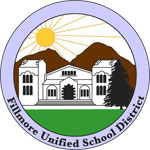|
District bids farewell to Superintendent Nishino
By Jean McLeod — Wednesday, June 18th, 2014
 Fillmore Unified School District The June 17, 2014 Fillmore Unified School District (FUSD) Board Meeting was the final meeting for Interim Superintendent Dr. Alan Nishino and Assistant Superintendent Michael Johnson, and was standing room only. There were many heartfelt goodbyes by teachers and Board Members to both outgoing superintendents. Board Member Tony Prado expressed his gratitude to Nishino in holding those employees accountable that were not holding up their end and their accomplishments. He gave high marks in what both men had achieved during their three years with the District. A public hearing item on the agenda, the use of Proposition 30 Education Protection Account, was discussed briefly with one person asking how much money the district received due to Prop. 30 and when it was received. Assistant Superintendent Business Services Deo Persaud responded, "Three and a half million this year...we receive one fourth of that amount every quarter. The law requires one hundred percent of the funds go to staff instruction (teachers)." Nishino then commented that the economy has improved, but California's economy fluctuates, "It is not as robust as they want us to believe....it's wise to keep a good reserve for the hard times." He went on to explain that the State now mandates that school districts keep in reserve a minimum of 3% and a maximum of 6%. Nishino said 9% is a much safer number and with parameters the State now requires, "You cannot plan for the worst and hope for the best...They're putting a big squeeze on us. This requirement just happened yesterday." He informed those in attendance that Governor Brown said there would be no more deferments, to which he responded, "I'll believe it when I see it." Nishino has reason to be skeptical; the State, for the past five years, has continually deferred payments (holding back payments) to schools. These deferments have resulted in many districts, including FUSD, having to borrow money to make payroll. Nishino informed everyone that the State still owes FUSD $300,000. During public comments a number of teachers and one parent addressed what they considered "too large of a classroom sizes for the K-3rd grades". The Board could not respond at that time because it would have been a Brown Act violation to directly answer or address those speaking during Public Comments, but the issue was addressed later during the meeting. The recent California school funding law called the Local Control Funding Formula (LCFF) requires school districts work toward a 24 students to one teacher ratio in K-3rd grades. It was reported during the meeting that Piru Elementary averages 27.2 students per teacher this year and expects that number to rise to 29 students next year. Other elementary schools in the district fare about the same; Mountain Vista 27.2 students and next year 29, San Cayetano 26.9 students and next year 28.5, Rio Vista 26.6 students and next year 28. Those in attendance were told there were two avenues the District could follow to address the issue. One was to come up with a number and work to achieve it or follow the LCFF formula to address class size. The District will be following the LCFF formula. A Public Hearing was held June 10, 2014 on the proposed 2014-15 budget of the FUSD, and was once again up for discussion. It received little response and was approved and adopted. There were also a number of agenda items up for approval by the Board. Most of the items had also been discussed at the June 10, 2014 FUSD Meeting. One of the approved items was Local Control Accountability Plan (LCAP) Education Code, which is part of LCFF. The LCAP requires districts to involve parents, students and teachers in the decision making. The LCFF, which allocates funds based on specific needs of students, is what replaced California's school budgeting when Governor Brown's presented the 2013 Education Budget. To produce the LCAP FUSD used newspaper announcements, made phone calls to parents and sent flyers home with students to get the community involved. As a result 175 participants (25 were teachers) came together during the first of three meetings to discuss the needs of the district. The second meeting 75 participated and the third meeting had 50 participate. When asked why the participation reduced in size Johnson stated "It was not a lack of interest, but the parents had come and relayed all their concerns and what they wanted to contribute." The were seven goals achieved through the collaboration of parents, teachers and administrators; (1)Increase student achievement at the primary level; (2) Create a safe and secure learning environment to enhance school climate; (3) Increase support structure to address the needs of at-risk students (4) Increase the use and effectiveness of educational technology; (5) Close the achievement gap between lower and higher achieving students (6) Increase enrollments to challenging and rigorous courses at all grades, e.g., GATE, CTE, CP, Honors and AP level courses; (7) Increase parent involvement and digital literacy for parents of English learners and low income students. Many of the parents who attended the LCAP meetings did not speak English and expressed their desire for a class to help them learn English. Johnson took on the task and started an English-As-A-Second-Language Class for an hour and a half each week. Eight of the parents who attended those classes came to Tuesday's meeting and sang Nat King Cole's 'Love' to demonstrate how much they had learned. |
